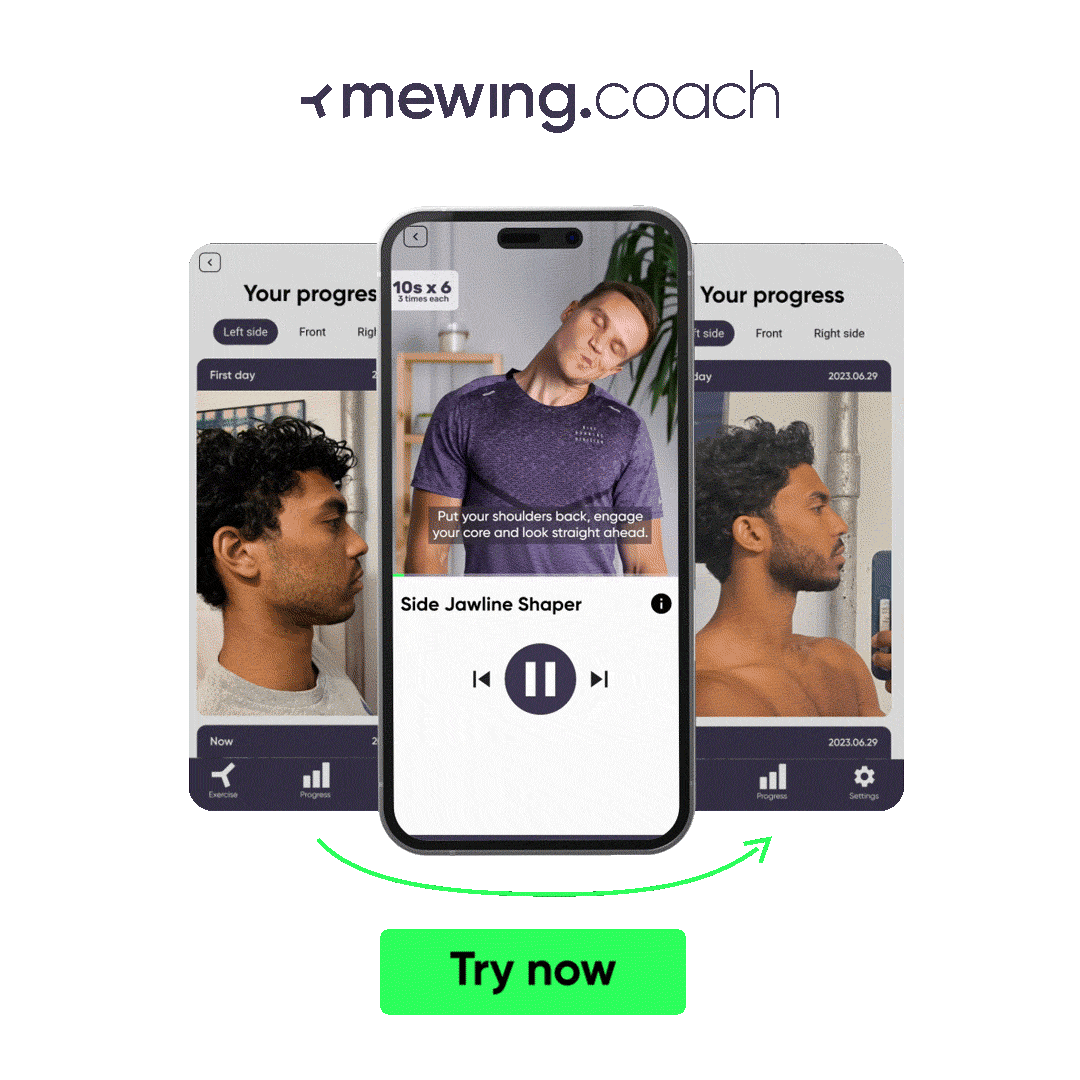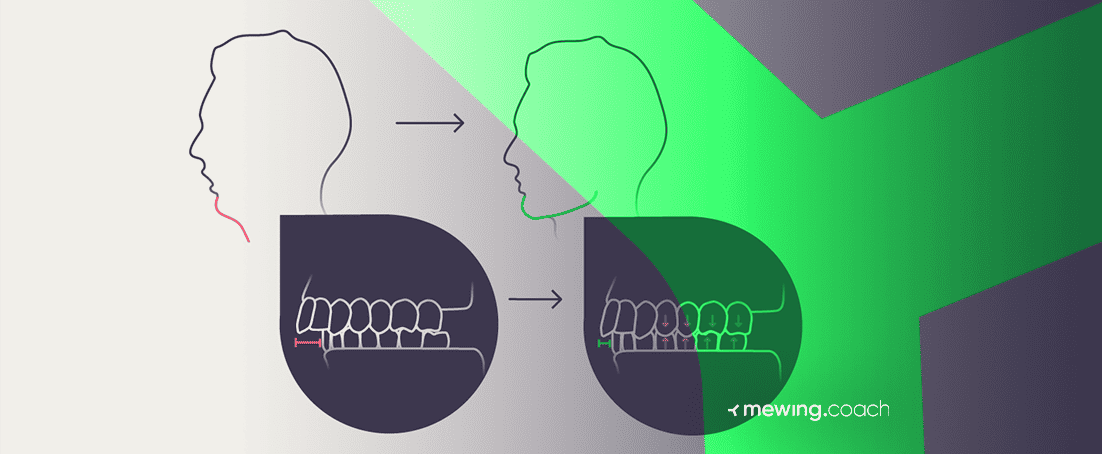
Mewing is all about proper tongue posture, improving the face shape, and making your cheekbones pop. But what about your teeth? Do they matter?
Of course, they do – more than you think! Teeth play a defining role in the formation of your face and the way it appears aesthetically. Practicing proper teeth placement is crucial to mastering the mewing technique.
Skip the long read and learn how to place your teeth and accelerate mewing results. Take a quiz below and get:
✅ Personalized mewing program (that’ll help you achieve proper teeth position)
✅ Daily exercises
✅ Guidance on how to reach your goals
✅ Video guides, tips, daily reminders, etc.
- 🔎 Revealed on this page:
- 📝 Correct teeth positioning while mewing explained.
- 📖 Reasons and risks of incorrect teeth positioning.
- 💪 What can help you correct your bite and get a perfect alignment?
Let’s get right to it and learn how to do the correct teeth position together.
Should Your Teeth Touch When Mewing?
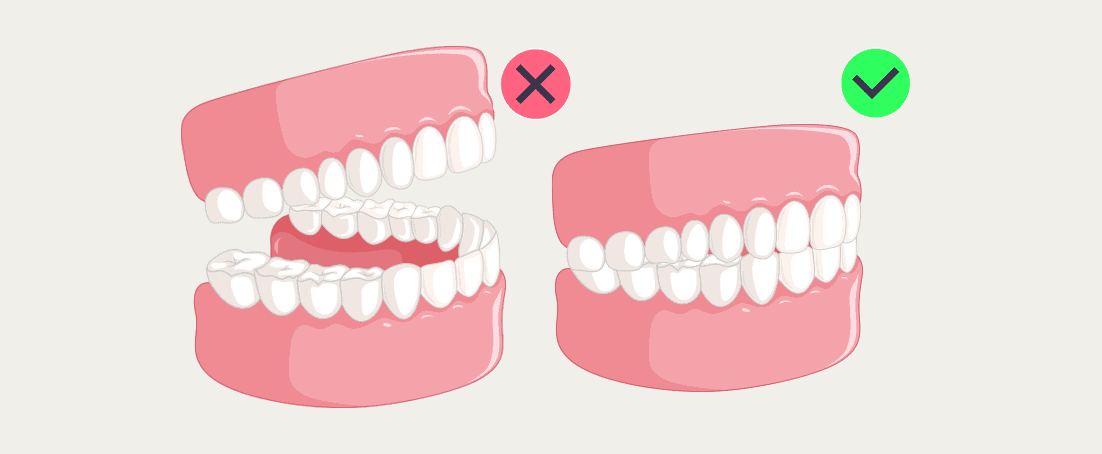
No, your teeth shouldn’t touch when mewing. They should be in a resting position.
This may come as a surprise, but your teeth aren’t supposed to touch when resting. Or ever, actually.
When chewing, the teeth bite through the food and never come into contact with each other. When resting, the mouth is closed, and they are held slightly apart.
So, How Are Teeth Supposed to Rest?
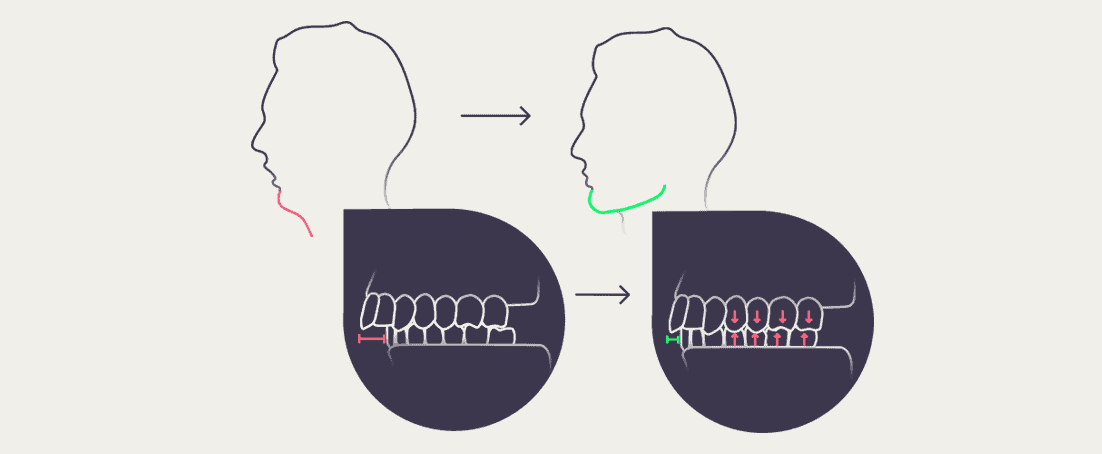
Teeth can rest differently depending on your jaw position.
You should be mindful of three things:
- Hold your mouth closed and lips sealed but relaxed. The jaw muscles are relaxed as well.
- Place the tongue behind the upper teeth without touching them.
- Keep the teeth apart with about 2-4 mm of space in between.
- While mewing, the teeth should be in a resting position. That is a key requirement for achieving a positive outcome.
What Is Mewing?
Mewing is a method of acquiring proper tongue posture introduced by British orthodontist John Mew. Mewing helps resolve many problems related to oral health and aesthetic issues if done persistently and correctly.
So, keeping your teeth in the resting position is a crucial element of the mewing technique.
Let’s explore some reasons you mustn’t touch your teeth when mewing.
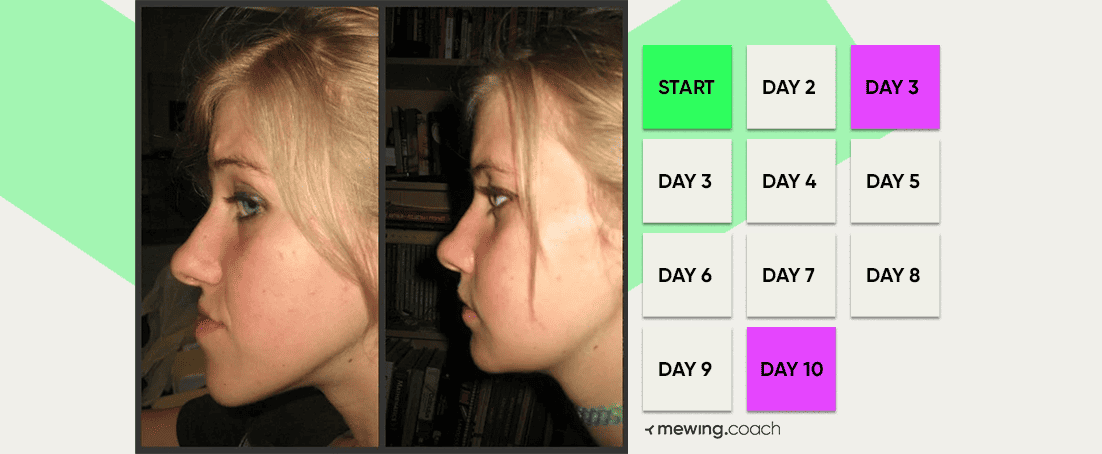
Reasons Your Lower & Upper Teeth Should NOT Touch While Mewing
Sitting apart is the teeth’s natural position and correct oral posture for people of all ages and face shapes. And it is absolutely paramount that your teeth don’t touch while mewing.
You must make sure you’re doing the technique properly in order for it to work. The exercises will help you learn the normal position of all the organs in the mouth and how to align the jaw bones and teeth and achieve facial symmetry.
That is why you should do it mindfully and eventually acquire the mewing habit as part of your everyday life. If you’re unsure whether you’re doing it the right way, check our tutorial on correct mewing and oral posture.
Should Teeth Rest When Sleeping?
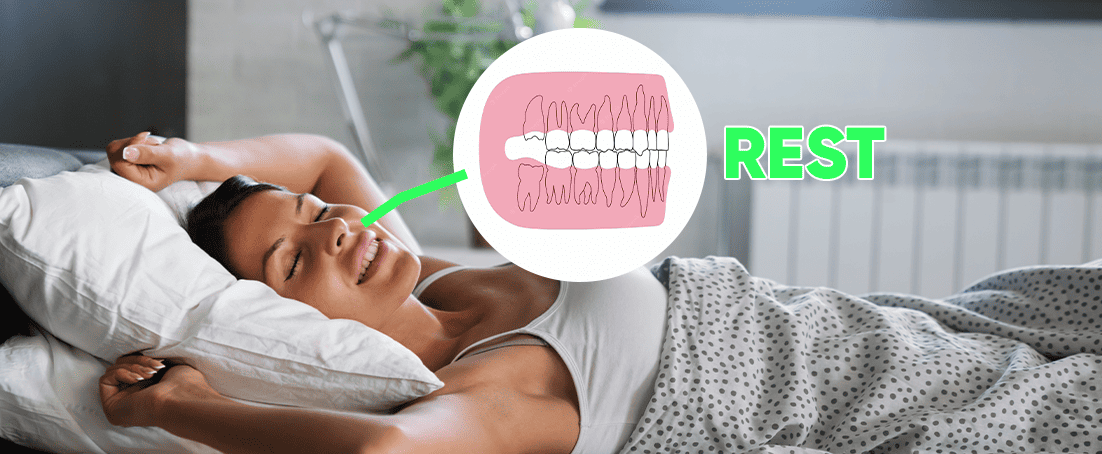
Yes, they should.
You must maintain the same resting teeth position throughout the day and night. Sleeping gives no grounds to justify teeth contact.
If your teeth are touching during sleep, you’re doing it subconsciously, with stress or anxiety, making you use force and hold the teeth clenched. You are contracting the masseters and grinding your teeth as you are trying to get relief from stress.
This condition is called bruxism and can lead to severe oral health complications, such as tooth damage, jaw pain, and headaches. If you’re wondering how mewing helps with bruxism treatment, you can try keeping the mewing tongue position at night to ensure the teeth aren’t touching.
Other reasons for teeth touching include issues with jaw misalignment or bite. All this can lead to discomfort in the TMJ area, chipped or broken teeth, and decay.
You can find tips on how to sleep while mewing correctly that will help you overcome many of your harmful nocturnal habits, including mouth breathing. Mewing and sleep apnea is another point we’ll discuss.
Should the Top Teeth Overlap the Bottom Teeth While Mewing?
Yes, they should, a little.
Let’s do a little test. Go up to your mirror, close your teeth, and open your mouth in a cheesy smile. In an ideal situation, the upper jaw sits in front of the lower jaw – but just slightly.
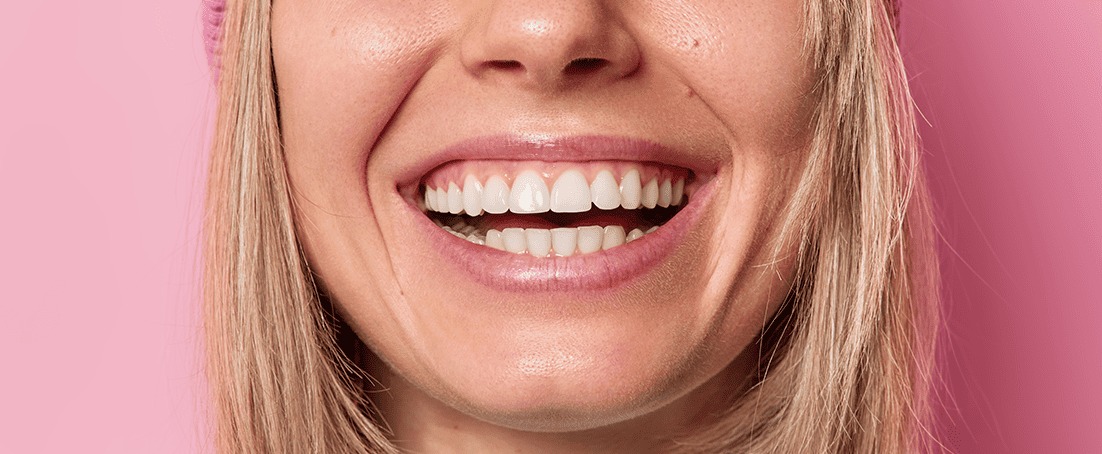
There is an overlap of your upper teeth measuring a few millimeters, and you can still see a large part of your lower teeth.
Now, set the teeth a little bit apart, and you will get the perfect mewing teeth position. There is a slight overlap but no touch.
Correct Tongue Position Behind the Teeth for Mewing

The mewing method requires that the tongue be lightly pressed against the roof of your mouth. The tip of the tongue lies on the slope of the palate behind the front teeth without touching them. The posterior third part of the tongue is raised, pressing against the palate.
For best results, you should maintain a good tongue posture at all times.
Why Your Tongue Shouldn’t Touch Your Teeth When Mewing
The tongue should not touch the teeth in order to maintain its natural position in the mouth. When mewing correctly, the whole tongue is raised to the palate and sits comfortably. You must learn to adopt this tongue position as part of your normal body functioning.
If you have just started mewing, try not to make any of the common mewing mistakes to avoid a potentially harmful outcome.
Another reason is the pressure. When the tongue pushes against your upper teeth, the pressure forces them to move outward. It is called a tongue thrust, a condition that can harm your oral health.
Risks of Incorrect Mewing Teeth Position
A prolonged incorrect teeth position (including touching your teeth) while mewing can lead to dental problems. Constant friction leads to bruxism and excessive tooth wear that often ends with costly dental treatments for tooth decay and caps on loose or chipped teeth.
Incorrect mewing can also cause a deformation of the upper and lower jaw. The asymmetry leads to TMJ disorder and pain, a bad bite, and further problems with chewing and eating.
Also, constant or prolonged pressure from the tongue can cause the teeth to shift, become crooked, develop a bad bite, and even result in teeth grinding and bruxism.
What Causes Difficulties in Achieving Perfect Mewing Position?
Many reasons make it challenging for some people to achieve a perfect mewing position. Usually, it has to do with teeth and jaw alignment, a bad bite, or wearing braces and other orthodontic treatment tools.
Let’s go over some of the top reasons below:
You Wear Braces
When your orthodontist prescribes braces, you should know whether they’re pushing your teeth inwards or outwards. If they push outwards, it is a perfect addition to mewing.
But if the braces work your teeth inwards, then two opposing forces push at your teeth. You might not see any results even after years of practice and exercise.
Also, braces can become a mewing obstruction. They might get in the way between your tongue and the roof of the mouth, making it virtually impossible to achieve correct tongue posture. Braces and mewing are not always compatible, but you can make them work well together.
However, Invisalign braces that only cover the teeth make the situation much easier. When wearing Invisalign and mewing at the same time, just make sure your tongue is close to the upper teeth but not touching the braces.
You Have a Sleep Retainer
Wearing a sleep retainer can prevent you from positioning the tongue on the palate. A part of the retainer runs across the roof of the mouth, making it impossible to practice the exercises correctly.
Also, sleep retainers pull the teeth inwards, whereas mewing means putting pressure forward and to the sides. It is impossible for these two opposing forces to work together.
You can find some tips on how mewing works with retainers on our page and use those different techniques to get better results.
You Have a Posterior Open Bite
A posterior open bite is when your front teeth touch but your back teeth don’t connect when the jaws are closed. There is space between the molars, which can cause trouble with chewing and swallowing and lead to a TMJ diagnosis.
This type of malocclusion can also cause the tongue to rest in a different position, making it more challenging to move up to the palate and stay pressed there. And your front teeth may still be touching while attempting to mew correctly.
Posterior open bite makes it harder to tackle problems with jaw posture and mouth breathing.
You Have Developed an Overbite
An overbite is a case of misaligned teeth when your upper teeth protrude beyond your lower front teeth. In cases of slight overbite caused by bad oral posture, mewing can help by improving the position of the lower jaw.
However, in some cases, it can worsen the situation due to maxilla expansion. Plus, it doesn’t work on pulling the teeth back into position.
There are uncertainties regarding overbite and mewing, and you must be sure that you’re positioning the tongue perfectly in order to achieve improvement in the bite.
You Have Developed an Underbite
An underbite means that your lower teeth extend farther than your upper teeth. The lower jaw protrudes forward, causing problems with breathing and chewing.
The main problem lies in the size of the maxilla. If the palate is too small and underdeveloped, it will be difficult to keep a correct tongue posture.
However, keeping the right position and putting pressure can help the maxilla expand and achieve optimal results. In addition, anecdotal evidence supports mewing for underbite and shows that it improves facial symmetry.
You Have Misaligned or Crooked Teeth
In severe cases, crooked teeth touch in all positions, making it difficult to achieve proper mewing teeth position. Sometimes it is impossible to hold teeth apart, so they keep bumping and grating, hindering proper tongue position.
Crossbite mewing exercises can help improve the situation. Still, you should be mindful of the way teeth make contact so as not to cause further chipping, grinding, and irregular wear to the enamel.
If You Have Trouble Holding a Correct Teeth Position
The Mewing.coach app is designed to help you sculpt your face into your desired look by practicing mewing exercises and boosting oral health without needing maxillofacial surgery. There, you will find guides and answers to all your questions – including problems with achieving a correct teeth position.
When you first open the app, answer the quiz questions that collect data about your age, weight, face shape, health, and aesthetic issues, and the main goals you want to achieve with this method. Then, the app prepares a workout program designed especially for your jaw and facial muscles based on your information.
Mewing Coach features will guide you on your road to improved appearance and overall health. It will show you the estimated period when you can expect to see mewing results.
The video tutorial will show you how to do the technique properly regarding tongue posture and teeth positioning. It will identify the zones that require the most attention and track your progress.
The daily in-app reminders will make sure you don’t skip sessions and help you turn mewing into a habit. And the personalized training program will focus on achieving your goals, whether a prominent jawline or building correct oral posture!
Mewing Benefits You’ll Experience Using the App
Most people who started mewing for aesthetic reasons soon realize all the health benefits and mewing advantages that it brings. The technique helps relieve the symptoms of all problems with malocclusion, such as bruxism, decay, tooth loss, and gum disease.
Correct jaw alignment increases the chances of achieving the right position of your teeth while doing the exercises. And correct teeth position plays a key role in doing the technique correctly and getting better results.
By strengthening the masseter muscles, you will get more power to push the mandible forward and align facial bones, significantly reducing the need for orthognathic surgery.
And proper tongue positioning will open the airways, which will help you breathe freely. Mewing helps with snoring and gasping for air while sleeping. You will forget about mouth breathing and feel immediate relief when you start to breathe through your nose.
Adopting the correct resting tongue position as a natural way of placing your tongue can resolve many other issues related to oral and general health.
So, get your personal Mewing Coach and make the first step to self-improvement and better self-image!
